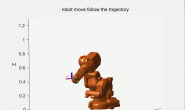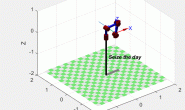1、前记:
这几天同样在MATLAB官网上学习了些机器人相关的基础知识。看到官方新推出的机器人系统工具箱(Robotics System Toolbox)的功能在很多方面都强于Robotics Toolbox,而且要更好的利用其学习必须结合到ROS一起学习。之前一直犹豫是因为不熟悉ROS和Ubuntu系统,另外想装虚拟机又嫌麻烦,但从长远看十分有必要学习ROS了,想到自己基础薄弱便担心其路途遥远啊~ ~//
上下求索吧,以下是一个涉及逆运动学的二维轨迹跟踪例子。用机器人系统工具箱函数做的,参看网址在文末。
%% 2-D Path Tracing With Inverse Kinematics
%% Introduction
% This example shows how to calculate inverse kinematics for a simple 2D
% manipulator using the <docid:robotics_ref.bvdhj7x-1 InverseKinematics> class.
% The manipulator robot is a simple 2-degree-of-freedom planar
% manipulator with revolute joints which is created by assembling rigid bodies into
% a <docid:robotics_ref.bvan8uq-1 RigidBodyTree> object. A circular trajectory is
% created in a 2-D plane and given as points to the inverse kinematics solver. The solver
% calculates the required joint positions to achieve this trajectory.
% Finally, the robot is animated to show the robot configurations that
% achieve the circular trajectory.
%本示例演示如何使用机器人来计算简单2D 机械手的逆运动学。
机械手机器人是一个简单的2自由度平面机械手,
它是通过将刚体装配成robotics.RigidBodyTree 对象。
在2维平面上创建一个圆形轨迹, 并将其作为反向运动学求解器的指向。
规划求解计算所需的关节位置以实现此轨迹。
最后, 对机器人进行了动画演示, 显示了实现圆形轨迹的机器人配置。
%
%% Construct The Robot
% Create a |RigidBodyTree| object and rigid bodies with their
% associated joints. Specify the geometric properties of each rigid body
% and add it to the robot.
% Start with a blank rigid body tree model
%构造机器人
创建一个RigidBodyTree对象和刚性体与他们的关联关节。指定每个刚体的几何性质并将其添加到机器人中。
从一个空白的刚体树模型开始
robot = robotics.RigidBodyTree('DataFormat','column','MaxNumBodies',3);
%%
% Specify arm lengths for the robot arm.//指定机械手臂的长度
L1 = 0.4;
L2 = 0.3;
%%
% Add |'link1'| body with |'joint1'| joint.//添加'link1'身体与'joint1'关节。
body = robotics.RigidBody('link1');
joint = robotics.Joint('joint1', 'revolute');
setFixedTransform(joint,trvec2tform([0 0 0]));
joint.JointAxis = [0 0 1];
body.Joint = joint;
addBody(robot, body, 'base');
%%
% Add |'link2'| body with |'joint2'| joint.//添加'link2'身体与'joint2'关节。
body = robotics.RigidBody('link2');
joint = robotics.Joint('joint2','revolute');
setFixedTransform(joint, trvec2tform([L1,0,0]));
joint.JointAxis = [0 0 1];
body.Joint = joint;
addBody(robot, body, 'link1');
%%
% Add |'tool'| end effector with |'fix1'| fixed joint.//添加 " 'fix1'固定接头的'tool'端效应器。
body = robotics.RigidBody('tool');
joint = robotics.Joint('fix1','fixed');
setFixedTransform(joint, trvec2tform([L2, 0, 0]));
body.Joint = joint;
addBody(robot, body, 'link2');
%%
% Show details of the robot to validate the input properties. The robot
% should have two non-fixed joints for the rigid bodies and a fixed body
% for the end-effector.
%显示机器人的详细信息以验证输入属性。机器人应该有两个非固定的关节
为刚体和一个固定的机构为末端执行器。
%
showdetails(robot)
%% Define The Trajectory
% Define a circle to be traced over the course of 10 seconds. This circle
% is in the _xy_ plane with a radius of 0.15.
%定义轨迹:定义一个圆, 在10秒的过程中跟踪。这个圆圈在 xy 平面上, 半径为0.15。
%
t = (0:0.2:10)'; % Time
count = length(t);
center = [0.3 0.1 0];
radius = 0.15;
theta = t*(2*pi/t(end));
points = center + radius*[cos(theta) sin(theta) zeros(size(theta))];
%% Inverse Kinematics Solution
% Use an |InverseKinematics| object to find a solution of robotic
% configurations that achieve the given end-effector positions along the
% trajectory.
%逆运动学解:使用InverseKinematics对象找到机器人配置的解决方案, 以实现沿轨迹给定的最终末端位置。
%%
% Pre-allocate configuration solutions as a matrix |qs|.//预分配配置解决方案作为矩阵qs.
q0 = homeConfiguration(robot);
ndof = length(q0);
qs = zeros(count, ndof);
%%
% Create the inverse kinematics solver. Because the _xy_ Cartesian points are the
% only important factors of the end-effector pose for this workflow,
% specify a non-zero weight for the fourth and fifth elements of the
% |weight| vector. All other elements are set to zero.
%创建反向运动学求解器。因为 xy 笛卡尔点是此工作流的末端姿态的唯一重要因素,
所以请为weight向量的第四和第五元素指定一个非零权重。所有其他元素都设置为零。
%
ik = robotics.InverseKinematics('RigidBodyTree', robot);
weights = [0, 0, 0, 1, 1, 0];
endEffector = 'tool';
%%
% Loop through the trajectory of points to trace the circle. Call the |ik|
% object for each point to generate the joint configuration that achieves
% the end-effector position. Store the configurations to use later.
%通过点的轨迹循环来跟踪圆。调用每个点的ik对象以生成实现末端位置的关节配置。存储要稍后使用的配置。
%
qInitial = q0; % Use home configuration as the initial guess
for i = 1:count
% Solve for the configuration satisfying the desired end effector
% position
point = points(i,:);
qSol = ik(endEffector,trvec2tform(point),weights,qInitial);
% Store the configuration
qs(i,:) = qSol;
% Start from prior solution
qInitial = qSol;
end
%% Animate The Solution
% Plot the robot for each frame of the solution using that specific robot
% configuration. Also, plot the desired trajectory.
%%
% Show the robot in the first configuration of the trajectory. Adjust the
% plot to show the 2-D plane that circle is drawn on. Plot the desired
% trajectory.
%对解决方案进行动画处理:使用特定的机器人配置为解决方案的每个帧绘制机器人。
同时, 绘制所需的轨迹。在轨迹的第一个配置中显示机器人。调整图形以显示2维平面,
该圆被绘制。绘制所需的轨迹。
%
figure
show(robot,qs(1,:)');
view(2)
ax = gca;
ax.Projection = 'orthographic';
hold on
plot(points(:,1),points(:,2),'k')
axis([-0.1 0.7 -0.3 0.5])
%%
% Set up a <docid:robotics_ref.mw_9b7bd9b2-cebc-4848-a38a-2eb93d51da03 Rate> object to display the robot
% trajectory at a fixed rate of 15 frames per second. Show the robot in
% each configuration from the inverse kinematic solver. Watch as the arm
% traces the circular trajectory shown.
%建立robotics.Rate对象以每秒15帧的固定速率显示机器人轨迹。
从逆运动学求解器中显示每个配置中的机器人。观察手臂跟踪显示的圆形轨迹。
%
framesPerSecond = 15;
r = robotics.Rate(framesPerSecond);
for i = 1:count
show(robot,qs(i,:)','PreservePlot',false);
drawnow
waitfor(r);
end
2、删掉汉字,运行结果
3、从以上格式继续添加一个link.
代码:
%%机器人创建
robot = robotics.RigidBodyTree('DataFormat','column','MaxNumBodies',4);
L1 = 0.3;
L2 = 0.3;
L3=0.2;
body = robotics.RigidBody('link1');
joint = robotics.Joint('joint1', 'revolute');
setFixedTransform(joint,trvec2tform([0 0 0]));
joint.JointAxis = [0 0 1];
body.Joint = joint;
addBody(robot, body, 'base');
body = robotics.RigidBody('link2');
joint = robotics.Joint('joint2','revolute');
setFixedTransform(joint, trvec2tform([L1,0,0]));
joint.JointAxis = [0 0 1];
body.Joint = joint;
addBody(robot, body, 'link1');
body = robotics.RigidBody('link3');
joint = robotics.Joint('joint3','revolute');
setFixedTransform(joint, trvec2tform([L2,0,0]));
joint.JointAxis = [0 0 1];
body.Joint = joint;
addBody(robot, body, 'link2');
body = robotics.RigidBody('tool');
joint = robotics.Joint('fix1','fixed');
setFixedTransform(joint, trvec2tform([L3, 0, 0]));
body.Joint = joint;
addBody(robot, body, 'link3');
%%定义圆的轨迹
t = (0:0.2:10)'; % Time
count = length(t);
center = [0.5 0.1 0];
radius = 0.2;
theta = t*(2*pi/t(end));
points = center + radius*[cos(theta) sin(theta) zeros(size(theta))];
%%机器人初始配置
q0 = homeConfiguration(robot);
ndof = length(q0);
qs = zeros(count, ndof);
%%逆运动求解
ik = robotics.InverseKinematics('RigidBodyTree', robot);
weights = [0, 0, 0, 1, 1, 0];
endEffector = 'tool';
qInitial = q0; % Use home configuration as the initial guess
for i = 1:count
% Solve for the configuration satisfying the desired end effector
% position
point = points(i,:);
qSol = ik(endEffector,trvec2tform(point),weights,qInitial);
% Store the configuration
qs(i,:) = qSol;
% Start from prior solution
qInitial = qSol;
end
%%动画显示
figure
show(robot,qs(1,:)');
view(2)
ax = gca;
ax.Projection = 'orthographic';
hold on
plot(points(:,1),points(:,2),'k')
axis([-0.1 0.7 -0.3 0.5])
framesPerSecond = 15;
r = robotics.Rate(framesPerSecond);
for i = 1:count
show(robot,qs(i,:)','PreservePlot',false);
drawnow
waitfor(r);
end
结果:
参看网址:https://ww2.mathworks.cn/help/robotics/ug/2d-inverse-kinematics-example.html#d119e6514







